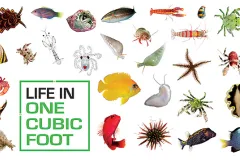Biocubes: Life In One Cubic Foot

How much life can you find in one cubic foot?
The answer will surprise you. It turns out, quite a lot! Biocubes are hollow one-foot cubic frames, that can be placed almost anywhere. They have been used to study mussel beds, rivers, trees, fields, coral reefs, and even the ocean midwater where there is nothing to cling to and no place to hide.
The Biocube program was inspired by a feature article in National Geographic that involved Smithsonian scientists and led to a book, "A World in One Cubic Foot: Portraits of Biodiversity." The sites featured in the book were documented by photographer David Liittschwager, assisted by a professional field crew and in consultation with various biologists. David set out to document how much life would pass through one cubic foot over the course of a normal day. The cubes were placed around the world and highlighted the staggering biodiversity revealed by studying one cubic foot at a time. Almost every cubic foot sampled yielded more than a hundred different species. Because of the standard sampling size, biocubes can be used to show interesting differences among living communities from different continents, different habitats, and wild versus domesticated land.
Green cubes aren't the only way to examine this type of diversity in a standard way. Similarly-sized devices called Autonomous Reef Monitoring Structures, or ARMS, are used on reefs around the world as a uniform way to measure reef diversity. Each ARMS is a tower of evenly-spaced, stacked plastic plates that are left on the ocean bottom. The unit acts as a little hotel for reef organisms to colonize. After a specific period of time, scientists then take them apart to see who moved in.
You can explore biocubes and ocean diversity from this page and learn how to build them yourself over on the National Museum of Natural History Q?rius website.

